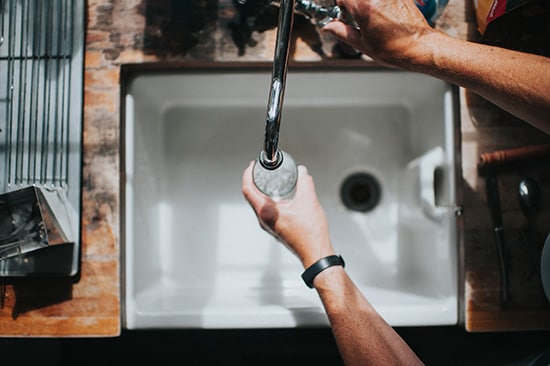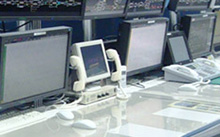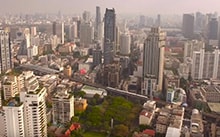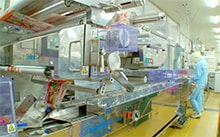Turning on the faucet allows us to access an endless supply of safe and delicious water. While completely taken for granted in Japan, this may change in the near future. This is because Japan's public water utilities are facing big challenges, such as the aging of plants and facilities built several decades ago, the financial difficulties of local governments caused by population declines, and the passing on of know-how possessed by retiring skilled technicians. The question is: what needs to be done to ensure the continuance of water utilities? By relying on technologies and expertise developed in its Social Innovation Business and on forefront, digital technology-based collaborative creation with local governing bodies and companies, Hitachi is assisting in the challenges of these governing bodies in their task of continuously delivering health and confidence to citizens through safe and delicious water.

Japan's water also exhibits high quality as drinking water but are often taken for granted. As there are few other countries where water can be drunk straight from the faucet, many visitors to Japan are surprised to see that water can be enjoyed right from the tap. This advantage is due to the Water Supply Act, which established water quality standards, and to the water purification facilities established and run by a large and skilled workforce to meet these strict standards.
However, the situation with water and sewage services in Japan is getting increasingly severe. The majority of domestic water and sewage services were developed during an intensive period of building during Japan's rapid economic growthin the 1960 - 70’s. Since then, water pipes and other water facilities have aged, leading to over 20,000 cases of water leakages and supply interruptions annually.
Meanwhile, revenues are declining because of decreases in regional water supply customers caused by such factors as the falling birth rate/aging population and regional depopulation. At the same time, investments in such projects as facility maintenance and earthquake resistance are on the rise. According to the Ministry of Health, Labour and Welfare, about 30% of local-government public water utilities are already operating at a loss.Aggravating the situation is the approximately 30% decrease from its peak in 1980 of the number workers taking part in water utility operations, which is causing issues in the passing on of necessary knowledge, such as water pipe leakage detection techniques and maintenance skills. Under these circumstances, it will be no easy task to continue providing safe and delicious water as in the past.
Simply put, Japan's water utilities are suffering a growing loss of people, money, and skills. As budgets for social infrastructure continue to shrink and as large-scale natural disasters continue to assail Japan, the infrastructure for water and sewage services must still be sustained somehow. Although a critical issue for Japan, it is also shared by the rest of the world.
The question is how to break out of these predicaments. One winning strategy is the strengthening of public-private partnerships. Such partnerships allow projects to benefit from private-sector management know-how and skills. Additional gains for the efficient and optimal operation of water utilities can also be realized by the application of advanced technologies, especially digital technologies.
Taking this perspective and leveraging over a century of providing a wide range of water environment solutions, Hitachi has partnered with domestic water and sewage services to roll out projects in a wide range of forms. Hitachi is working to create sustainable water and sewage systems.
Collaborative Creation with Hakodate City
One example of this is our collaborative creation with the city of Hakodate in Hokkaido. Hakodate provides water-supply services to about 260,000 people (as of March 2018) and has run a stable water utility operation based on a philosophy of providing safe and clean water in harmony with nature. While the utility works at keeping its income and expenditure stable, it has similar problems with other regions: water purification plants, pipelines, and other facilities are aging, and experienced workers are reaching retirement.
Hakodate itself has seen a drop in population from its peak of 345,165 in 1980 to 265,979 in 2015. Water revenues have also fallen from about 4.5 billion yen in 2006 to about 4.1 billion yen in 2015, while the number of people engaged in work involving the city's water and sewage services has also seen a decline of 76 from 2006 to 186 by the end of 2015.
With an eye toward future challenges, Hakodate solicited proposals based on a “Design Build Operate” (DBO) model. In such project, the building work is conducted by the public sector, while operations are handled by the private sector. This resulted in the awarding of a project contract in March 2019 to Hakodate Aqua Solution, a consortium comprising Hitachi, Tomioka Electric Construction, and Hitachi High-Tech Fielding Corporation.
Highlights of this project are its long term of 20 years and that it allows the public to freely make proposals in accordance with changes in the project situation. With the project having just begun in April 2019, the public has already started making various types of new proposals and initiating various forms of verifications.
This is reflected, for example, in the plant facility design of water purification plants. In addressing how to integrate water purification plants as the water service population decreases, optimal proposals are being made that cover such items as water intake points and water pipe layouts, while watching the water quality of the water resources. Other initiatives that have been started include residual salt control for maintaining safe water, the drafting of improvement plans for operation and maintenance management work, and the digitalization of field inspection work facilitated by newly introduced facility management systems.
In addition, the project has plans to boost the acceleration of work streamlining and cost reduction as it moves forward with demonstrations of digital solutions, including“work navigation implementation”, “plant operation support”(an AI system that uses operational history), and “water quality forecasting”.

Left: Ofuna Water Purification Plant; right: field inspections

Scheme of O&M Support Digital Solution
Addressing the issue of how to develop safe, secure, and sustainable water utilities requires not only high-quality facilities and systems for water purification plants and sewage treatment plants, but also general optimization based on a broad spectrum of linkages between OT and IT.
In this respect, Hitachi has for many years been providing reliability-first, stability-first, and safety-first water environment solutions comprising various systems and services for water and sewage service providers—all intended to support lifelines. In particular, Hitachi has a considerable track record of delivering monitor control systems that form the core of water and sewage systems, with installations reaching about 2,100.
O&M*1 Support Digital Solution, a cloud-based service for water and sewage services that uses IoT, represents the systemization of this extensive business track record and experience.
This solution makes use of Lumada, Hitachi’s unique solutions for accelerating digital innovation. In this system, various water/sewage facility data, including operational information, work records, and equipment failure and repair information, is gathered in the cloud using IoT, where forefront digital technologies such as AI, analytics, and Augmented Reality (AR) are used to support the visualization, labor-saving, and streamlining of operational and maintenance work, and also the passing on of know-how and expertise.
Beginning with the city of Hakodate, initiatives using this solution are being executed for the water utilities of several other municipalities. This same solution is also delivering tremendous benefits in the water and sewage service comprehensive contracts entered into the city of Toda in Saitama Prefecture.
One example of this is the introduction of tablet-based maintenance and inspection in order to improve operation management. Evidence comprising of when and who conducted field inspection work has been converted into data. The organization, visualization, and analysis of this data will make it useful in solving a variety of issues, from the early detection of faults to the streamlining of operations.
Video: Toda City’s Initiatives for the Water Supply and Sewage Businesses
We have also begun the Proof of Value (PoV) process, which is aimed at enabling anyone to draft appropriate operation plans by using AI to analyze pump control—a task that has so far been performed manually by skilled technicians. The conventional way for pump operators to judge the timing of pump startup and shutdown was to look at various conditions based not only on immediate operational information, but also on such factors as historical operation records and current and past weather. Operator ingenuity has been responsible for accomplishing improvements to work efficiency and to the maintenance of operation quality in emergency response, which is necessary to deal with such things as power outages caused by earthquakes or lightning. Unfortunately, the large number of operators having such extensive experience is set to decline. A solution to this dilemma lies in using AI to analyze patterns in the form of historical operation records, making possible efficient and stable pump operation that does not depend on operator skills. Another beneficiary is the transmission of skills to the next generation.
As the company puts into practice various collaborative creation projects, Hitachi will continue to add functions to the O&M Support Digital Solution while continuing to expand its solutions covering pipeline management, utility management, and other activities.

Western Water Purification Plant

Nizo Public Sewerage Pump Facility
Japan is not the only country facing water utility challenges. Many other countries and regions around the world are also burdened with unsolved challenges. These include the long-standing issue of being unable to supply safe water and complex issues concerning the inability to supply water and sewage services for such reasons as rapid population growth, weather fluctuations, and environmental degradation.
Much like Japan, other developed countries also have significant problems with social infrastructure. In England, it is said that London's waterworks have a leakage rate of over 25%. And even though emerging nations have built infrastructure, they lack operational know-how. Subsequent water shortages have produced a health crisis, creating a need for safe drinking water services and for environmental improvement to water areas.
Targeting solutions for the challenges of global water utilities, Hitachi will continue to combine its strengths in IT, OT, and products with collaborative creation carried out with domestic and overseas partners to provide total one-stop solutions that cover all stages of development and use, from design and construction to operation of the systems being run. In this way, Hitachi Group is contributing to water utility improvement on a global scale and to sustainable urban and improved quality of life.
Release Date: November 2019
Solutions By: Water Solutions Division, Water & Environment Business Unit, Hitachi, Ltd.








Water Environment Solutions
 Hitachi can contribute to solve
Hitachi can contribute to solve